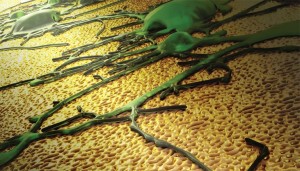
Nanoporous gold features high effective surface area, tunable pore size, and high electrical conductivity and compatibility with traditional fabrication techniques.
Image: Ryan Chen/LLNL
Researchers from Lawrence Livermore National Laboratory and the University of California, Davis have recently published a paper showing that covering an implantable neural electrode with nanoporus gold could potentially eliminate the risk of scar tissue forming over the electrode’s surface.
Two former ECS member, Erkin Seker and Juergen Biener, were among the researchers involved with this development.
This from Lawrence Livermore National Laboratory:
The team demonstrated that the nanostructure of nanoporous gold achieves close physical coupling of neurons by maintaining a high neuron-to-astrocyte surface coverage ratio. Close physical coupling between neurons and the electrode plays a crucial role in recording fidelity of neural electrical activity.
“We found that nanoporous gold reduces scar coverage but also maintains high neuronal coverage in an in vitro neuron-glia co-culture model,” said Biener. “More broadly, the study demonstrates a novel surface for supporting neuronal cultures without the use of culture medium supplements to reduce scar overgrowth.”
The properties of the nanoporus gold make it ideal for use in electrochemical sensors and catalytic platforms.
Want to learn more about this topic? Check out some of the papers that Seker and Biener published with ECS:


